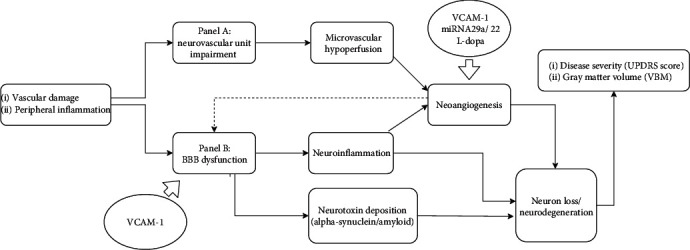Figure 2.

Vascular factors of Parkinson disease, modified by two hit vascular model references [6]. Peripheral inflammation with vascular factor-like hypertension, diabetes, aging process, and genetic factors for PD, leading to neurovascular unit (NUV) impairment (panel A) and BBB dysfunction (panel B). In panel A, abnormal neurovascular alterations cause changes in vascular perfusion in the cerebral blood flow and oxygen consumption and cerebral flow hypoperfusion with small vessel atherosclerosis, further leading to neoangiogenesis and neuroinflammation. In panel B, peripheral inflammation and the aging process can cause BBB dysfunction, with inflammatory factors infiltrating into the neurons and adjacent supporting tissue. Inflammation also causes neurotoxin accumulation in brain tissues and vascular damage that changes microvessel integrity, leading to microvascular hypoperfusion (oligaemia) and inducing neoangiogenesis, which in turn result in macrobrain structural changes like white matter hypertrophy and gray mater atrophy, which are in turn correlated with clinical disease progression. Abbreviations: VCAM-1: vascular cell adhesion molecule-1; UPDRS: Unified Parkinson's Disease Rating Scale; VBM: voxel-based morphology.
